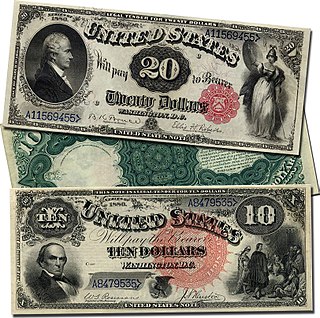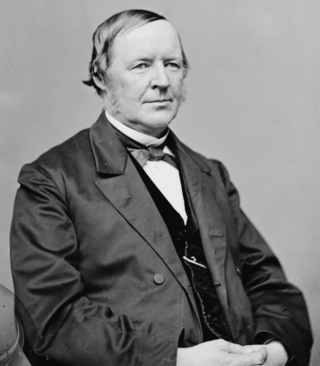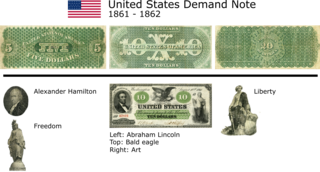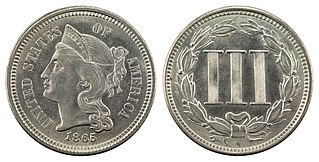Related Research Articles

The National Banking Acts of 1863 and 1864 were two United States federal banking acts that established a system of national banks, and created the United States National Banking System. They encouraged development of a national currency backed by bank holdings of U.S. Treasury securities and established the Office of the Comptroller of the Currency as part of the United States Department of the Treasury and a system of nationally chartered banks. The Act shaped today's national banking system and its support of a uniform U.S. banking policy.
The Specie Payment Resumption Act of January 14, 1875 was a law in the United States that restored the nation to the gold standard through the redemption of previously-unbacked United States Notes and reversed inflationary government policies promoted directly after the American Civil War. The decision further contracted the nation's money supply and was seen by critics as an exacerbating factor of the so-called Long Depression, which struck in 1873.

A United States Note, also known as a Legal Tender Note, is a type of paper money that was issued from 1862 to 1971 in the U.S. Having been current for 109 years, they were issued for longer than any other form of U.S. paper money. They were known popularly as "greenbacks", a name inherited from the earlier greenbacks, the Demand Notes, that they replaced in 1862. Often termed Legal Tender Notes, they were named United States Notes by the First Legal Tender Act, which authorized them as a form of fiat currency. During the early 1860s the so-called second obligation on the reverse of the notes stated:
This Note is a Legal Tender for all debts public and private except Duties on Imports and Interest on the Public Debt; and is receivable in payment of all loans made to the United States.
The Greenback Party was an American political party with an anti-monopoly ideology which was active between 1874 and 1889. The party ran candidates in three presidential elections, in 1876, 1880 and 1884, before it faded away.

Lot Myrick Morrill was an American statesman and politician who served as the 28th Governor of Maine, as a United States Senator, and as U.S. Secretary of the Treasury under President Ulysses S. Grant. An advocate for hard currency rather than paper money, Morrill was popularly received as Treasury Secretary by the American press and Wall Street. He was known for financial and political integrity, and was said to be focused on serving the public good rather than party interests. Morrill was President Grant's fourth and last Secretary of the Treasury.

Hugh McCulloch was an American financier who played a central role in financing the American Civil War. He served two non-consecutive terms as U.S. Treasury Secretary under three presidents. He was originally opposed to the creation of a system of national banks, but his reputation as head of the Bank of Indiana 1857 to 1863 persuaded the Treasury to bring him in to supervise the new system as Comptroller of the Currency 1863–65. As Secretary of the Treasury 1865–69 he reduced and funded the gigantic Civil War debt of the union, and reestablished the federal taxation system across the former Confederate States of America. He tried but failed to make a rapid return to the gold standard.

Coin's Financial School was an 1894 pamphlet written by lawyer, politician and resort founder William Hope Harvey (1851–1936). It advocated a return to bimetallism, where the value of a monetary unit is defined as a certain amount of two different kinds of metals, often gold and silver. In the book, Harvey charged that the demonetization of silver caused by the Coinage Act of 1873 led to the Panic of 1893 by halving the supply of available redemption money in the economy. This lowered the prices of goods throughout the country and hurt farmers and small business owners, according to Harvey. Harvey argued that by returning silver to the same monetary status as gold, the American economy would benefit from stabilized prices, resulting in higher revenue, and ease of repayment of debts. The pamphlet sold about 1 million copies, which helped popularize the free silver movement with the public. Harvey would go on to aid Democratic candidate William Jennings Bryan’s presidential campaign in 1896, which ran on the platform of free coinage of silver. The issue of bimetallism remained controversial throughout the remainder of the 19th century.
The Revenue Act of 1862, was a bill the United States Congress passed to help fund the American Civil War. President Abraham Lincoln signed the act into law on July 1, 1862. The act established the office of the Commissioner of Internal Revenue, a department in charge of the collection of taxes, and levied excise taxes on most items consumed and traded in the United States. The act also introduced the United States' first progressive tax with the intent of raising millions of dollars for the Union.
The history of the United States dollar began with moves by the Founding Fathers of the United States of America to establish a national currency based on the Spanish silver dollar, which had been in use in the North American colonies of the United Kingdom for over 100 years prior to the United States Declaration of Independence. The new Congress's Coinage Act of 1792 established the United States dollar as the country's standard unit of money, creating the United States Mint tasked with producing and circulating coinage. Initially defined under a bimetallic standard in terms of a fixed quantity of silver or gold, it formally adopted the gold standard in 1900, and finally eliminated all links to gold in 1971.

A Demand Note is a type of United States paper money that was issued from August 1861 to April 1862 during the American Civil War in denominations of 5, 10, and 20 US$. Demand Notes were the first issue of paper money by the United States that achieved wide circulation and they are still in circulation today, though they are now extremely rare. The U.S. government placed the Demand Notes into circulation by using them to pay expenses incurred during the Civil War including the salaries of its workers and military personnel.

Greenbacks were emergency paper currency issued by the United States during the American Civil War that were printed in green on the back. They were in two forms: Demand Notes, issued in 1861–1862, and United States Notes, issued in 1862–1865. A form of fiat money, the notes were legal tender for most purposes and carried varying promises of eventual payment in coin, but were not backed by existing gold or silver reserves.

The United States dollar is the official currency of the United States and several other countries. The Coinage Act of 1792 introduced the U.S. dollar at par with the Spanish silver dollar, divided it into 100 cents, and authorized the minting of coins denominated in dollars and cents. U.S. banknotes are issued in the form of Federal Reserve Notes, popularly called greenbacks due to their predominantly green color.

The Public Credit Act of 1869 in the USA states that bondholders who purchased bonds to help finance the Civil War would be paid back in gold. The act was signed on March 18, 1869, and was mainly supported by the Republican Party, notably Senator John Sherman.

A Treasury Note is a type of short term debt instrument issued by the United States prior to the creation of the Federal Reserve System in 1913. Without the alternatives offered by a federal paper money or a central bank, the U.S. government relied on these instruments for funding during periods of financial stress such as the War of 1812, the Panic of 1837, and the American Civil War. While the Treasury Notes, as issued, were neither legal tender nor representative money, some issues were used as money in lieu of an official federal paper money. However the motivation behind their issuance was always funding federal expenditures rather than the provision of a circulating medium. These notes typically were hand-signed, of large denomination, of large dimension, bore interest, were payable to the order of the owner, and matured in no more than three years – though some issues lacked one or more of these properties. Often they were receivable at face value by the government in payment of taxes and for purchases of publicly owned land, and thus "might to some extent be regarded as paper money." On many issues the interest rate was chosen to make interest calculations particularly easy, paying either 1, 1+1⁄2, or 2 cents per day on a $100 note.

Confederate war finance involved the various means, fiscal and monetary, through which the Confederate States of America financed its war effort during the American Civil War of 1861-1865. As the war lasted for nearly the entire existence of the Confederacy, military considerations dominated national finance.
Willard v. Tayloe, 75 U.S. 557 (1869), was a decision by the Supreme Court of the United States that courts of equity deciding issues of contract have discretion to determine the form of relief based on the circumstances of each individual case. The Court established a new rule to determine the form of relief: Relief should serve the ends of justice, and should be withheld if it appears likely to produce hardship or injustice to either party.
This article is about the history of monetary policy in the United States. Monetary policy is associated with interest rates and availability of credit.

The copper-nickel three-cent piece, often called a three-cent nickel piece or three-cent nickel, was designed by US Mint Chief Engraver James B. Longacre and struck by the United States Bureau of the Mint from 1865 to 1889. It was initially popular, but its place in commerce was supplanted by the five-cent piece, or nickel.

John Sherman was an American politician from Ohio throughout the Civil War and into the late nineteenth century. A member of the Republican Party, he served in both houses of the U.S. Congress. He also served as Secretary of the Treasury and Secretary of State. Sherman sought the Republican presidential nomination three times, coming closest in 1888, but was never chosen by the party.
The economic history of the American Civil War concerns the financing of the Union and Confederate war efforts from 1861 to 1865, and the economic impact of the war.
References
- ↑ Brands, 2011, p. 1
- ↑ The Continental Dollar: What Happened to it after 1779?, Farley Grubb, NBER Working Paper No. W13770, February 2008.
- ↑ Friedberg, Arthur L. and Ira S., 2006, Paper Money of the United States, 18th Edition, Clifton, NJ, The Coin & Currency Institute, Inc. ISBN 0-87184-518-0